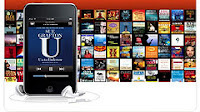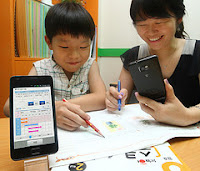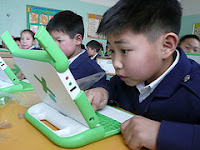Since the beginning of time the way people have learned and absorbed useful information has changed in many ways. Today's educational opportunities through new technology and abundant resources are a drastic change from previous generations.
Although still used today, educational resources such as textbooks have become secondary resources next to using computers, and other technology. The iPod has made the way students learn in school much more enjoyable and innovative. Emerging technologies like the iPod is making the old ways of teaching a thing of the past.
The following list is the top ten ways to use iPods in the classroom:
 1. Find The Missing Song Lyrics: Chances are you learned the alphabet through a song. That is because songs are a powerful way to ingrain words and ideas in a student's head.
1. Find The Missing Song Lyrics: Chances are you learned the alphabet through a song. That is because songs are a powerful way to ingrain words and ideas in a student's head.This type of activity is especially popular in foreign language classes. A teacher can put a song on an iPod in whatever the language they are being taught. The teacher then can print out the lyrics for the song, with selected words being removed, and then finally the teacher can play the song and have the students listen to the song. After they listen to the song or while they are listening they can determine the missing words to the song.
 2. Audio Books: These are newer version of books on tape or books on cassette. These can be used for all types of situations. If students are maybe falling behind the others or want to get ahead and would rather listen to the book to get more out of it they can listen to the book on an iPod through headphones or a listening center.
2. Audio Books: These are newer version of books on tape or books on cassette. These can be used for all types of situations. If students are maybe falling behind the others or want to get ahead and would rather listen to the book to get more out of it they can listen to the book on an iPod through headphones or a listening center. Not just individual students can use the audio books, but the teacher can make it so that the entire class does as well. This would be very practical if the teacher lost his or her voice and she still wanted the kids to read as a group. Just play the iPod through a listening center and you're good to go.
3. Audio Book Part 2: Do you struggle encouraging creative writing?
Have the students listen to a book on tape but stop it at a certain point. Do not let them listen to the ending of a chapter or a book.
Instead of having them hear the ending have them write there own ending first. This will spark creativity into their heads and will make them even more interested in how it was originally written to end. The perfect listening center for audio books, sing-a-longs and teaching song lyrics is Digital iPod Listening Center from AmpliVox

4. iPod Voice Recorder: The most natural way to develop language and pronunciation skills is through listening to proper pronunciation and practicing it themselves. The voice recorder can be used with kids that are learning a new language, or kids with speech problems.
The speech teacher can record the way that the word or phrase is properly pronounced. Then, the student can listen to how it is pronounced and practice saying it the proper way. By recording themselves saying it over and over they can hopefully learn the proper way to say it.
5. Use In an Amplified Classroom : The iPod Portable PA System from AmpliVox is perfect to be used in a classroom setting. This product can be used with the iPod Touch, iPhone, iPod Classic, and iPod Nano. It is a versatile product and can be used in many different ways.
One great way this product can be used is for showing a movie because it also has a built in DVD player and the system has a wireless microphone. The ducking feature allows presenters to speak over music or a movie that is being played through the PA system.
Blog Post: Amplified Classroom Statistics
Product Video: iPod PA System
 6. Study Tools: To further gain more knowledge, students may turn to study tools like iPhone Apps or Spark Notes. For a while they were solely available on the Internet but now they can be purchased as an iPod application as well.
6. Study Tools: To further gain more knowledge, students may turn to study tools like iPhone Apps or Spark Notes. For a while they were solely available on the Internet but now they can be purchased as an iPod application as well. Study tools like Spark Notes are a good way of helping get a better grasp of what a chapter was about or get more information about a literary character.
7. Educational Podcasts: This is especially popular with college students. Sometimes your professor talks too fast for your comfort or maybe it was just very hard to pay attention one way and did not jot everything down.
Not every school does this but some schools fortunately enough some have schools have allowed professors to post the audio version of a lecture. What a useful tool this can be for students and teachers.
8. Testing Listening: Listening not to be confused with hearing, is something that needs to be taught and reinforced on how important it is at an early age. To test out children's listening skills, teachers could put a basic listening test on an iPod and have each student take it.
Whether it is on their own with headphones in or with an amplified iPod listening center, the main component with the listening test is to make sure that they following the directions and listening to what it is
telling them to do.
9. Drawing: Have your students listen to a piece of music or a song. After listening have them draw what they listened too. There is no right or wrong way to do this exercise. This would be perfect for an art or creative drawing class.
10. Reward: This would again fall under the category for the younger aged students. Reward the children for good behavior, good grade on a test or quiz even. Reward the student who earned the right to use the iPod and it will then encourage the other students to prepare better for the next quiz.

How do you use iPods in the classroom? Share in a comment!
Blog: Top Ten Reasons to Use Technology in the Classroom
Blog: 15 Brilliant Albert Einstein Quotes on Education
Video: Top Ten Classroom Management Tips for Teachers
Image Credits: Jarret , wlibrary, UNHCR, Mountain Mike , petesahut_ph13166, Rock Star2005, Orange_Beard, lara , jasonr611








